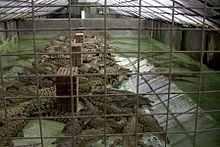Crocodile farm



An alligator farm or crocodile farm is an establishment for breeding and raising of crocodilians in order to produce meat, leather, and other goods. Many species of both alligators and crocodiles are farmed internationally, and occasionally the term ranch is also used.
History
Though not truly domesticated, alligators and crocodiles have been bred in farms since at least the early 20th century. However, the vast majority of these early businesses were farms in name only; primarily keeping alligators and crocodiles as a tourist attraction.[1] The St. Augustine Alligator Farm Zoological Park, established in 1893, is a prime example of this early type of alligator farm. Only in the 1960s did commercial operations that either harvested eggs from the wild or bred alligators on-site begin to appear.[2] This was largely driven by diminishing stocks of wild alligators, which had been hunted nearly to extinction around this time.
As the American Alligator was placed under official protection in 1967 (under a law preceding the 1973 Endangered Species Act) farming alligators for skins became the most viable option for producing leather (aside from illegal poaching).[2] Mostly concentrated in the Southern U.S. states of Louisiana, Florida, and Georgia, the practice quickly spread to other nations. Both the American and Chinese Alligator are farmed intensively today, mostly within each species' respective native region. The Nile crocodile is found in ranches all over Africa, and the Saltwater crocodile is farmed in Australia and other areas. The smaller caimans are generally not of enough market value to farm, though some captive breeding of the spectacled caiman does take place in South America.
Farming alligators and crocodiles first grew out of the demand for skins,[3] which can fetch hundreds of dollars a piece. But alligator and crocodile meat, which was long a part of Southern cooking (especially Cajun cuisine)[4] and some Asian and African cuisines, began to be sold later and shipped around the world to markets unfamiliar with crocodilian meat. Chinese cuisine based on traditional Chinese medicine considers alligator meat to be a curative food for colds and cancer prevention, although there is no scientific evidence to support this.[5]
Complications
Many diseases and complications arise with alligator farming.Many landowners across the United States are experiencing problems with poroperty damage from Sus scrofa L. (Fera 1 Swine), which are expanding their range(Ditchkoff and Mayer2009, Mayer
In addition, feral swine flu not only causes deleterious effects on wetlands but a major financial impact of the loss of alligators eggs is the most vital issue." [6]
In addition to feral swine.. "between 2001 and 2003, West Nile virus (WNV) infections and associated deaths were reported in captive American alligators (Alligator mississippiensis) in Georgia, Florida, Louisiana, and Idaho (Miller et al. 2003, Jacobson et al. 2005, Nevarez et al. 2005)." The result of WNV in alligators was a huge economic loss to alligator farming. There was a study done to find species composition and presence of WNV in mosquito populations linked with alligator farms in Louisiana. This study was also done to find the origin of mosquito blood meals collected at commercial alligator farms."The study strongly suggests that mosquitoes play an important role in WNV transmission for captive alligators, and efforts to control mosquitoes at commercial alligator farms may be beneficial in reducing WNV transmission". [7]
Popular culture
A crocodilian farm in Louisiana is featured in the 1973 James Bond film Live and Let Die. Tee Hee Johnson, one of the villain's henchman, attempts to feed James Bond to the alligators and crocodiles.
In the second season of The Amazing Race Australia, teams had to visit a Cuban alligator farm and feed a wheelbarrow full of chum to a pen of alligators along with capturing an alligator with a stick and rope in order to receive their next clue.
References
- ^ "Crocodiles and Alligator Farms". Americana-alligator.com.
- ^ a b Medley, Cynthia (January 18, 1970). "One Way to Halt Poaching-Gator Farming". The New York Times. Retrieved 2009-02-08.
- ^ Lyman, Rick (November 30, 1998). 20th "Anahuac Journal; Alligator Farmer Feeds Demand for All the Parts". The New York Times.
{{cite news}}: Check|url=value (help) - ^ Marcus, Frances Frank (April 4, 1993). "Louisiana Alligator, From Pies to Picante". The New York Times.
- ^ Chang, L. T., and Olson, R.. Gilded Age, Gilded Cage. National Geographic Magazine, May 2008.
- ^ Attention: This template ({{cite doi}}) is deprecated. To cite the publication identified by doi:10.1656/058.011.0204 , please use {{cite journal}} (if it was published in a bona fide academic journal, otherwise {{cite report}} with
|doi=10.1656/058.011.0204instead. - ^ Template:Cite www.bioone.org/doi/full/10.1603/ME09087
External links
- The short film Alligator Aquaculture in the South is available for free viewing and download at the Internet Archive.
